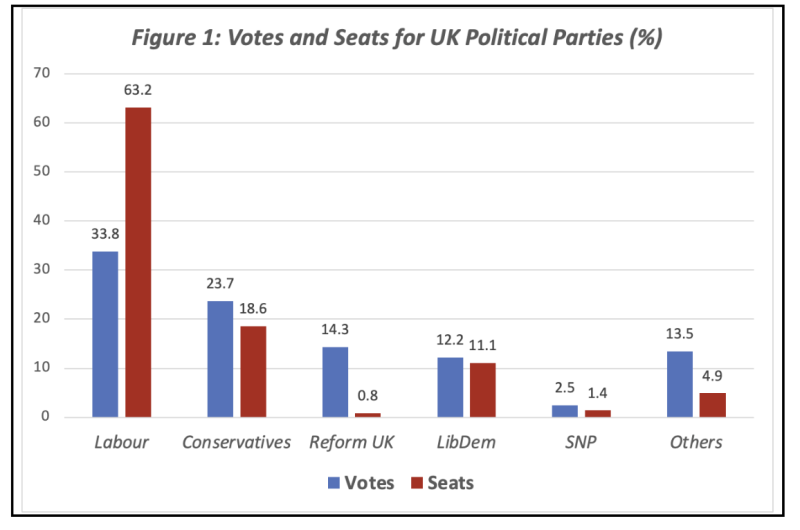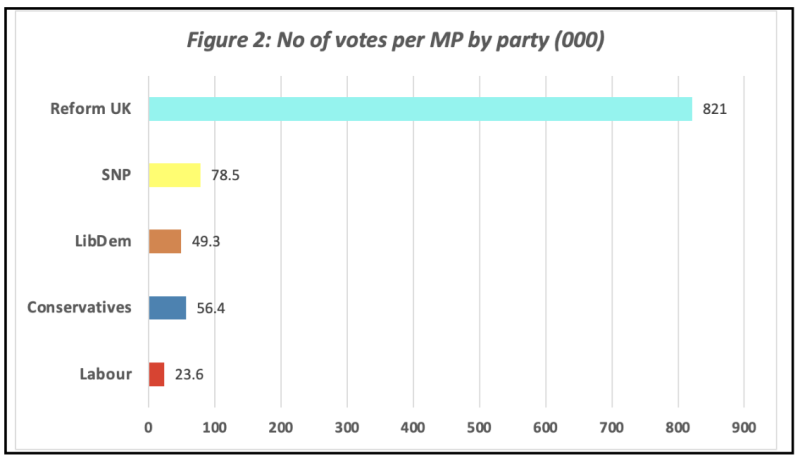
Two weeks ago, I wrote about the rise of the New Right and its challenge to the liberal consensus on social, economic, and environmental policies; the displacement of the old left-right ideological divide by that between the inner city managerial-technocratic elite and the inhabitants of Hiluxland; and the growing disenchantment with democracy because of the distortions through which voter preferences fail to translate into political representation. All three propositions have been confirmed by the British election. Never in democratic history have so many been elected by so few.

The punishment of the Tories by enraged former supporters who have been waiting for elections with baseball bats to the ready did not equate to an endorsement of Labour. Four out of every five eligible voters either refused or else failed to vote for Starmer’s Labour. The biggest short-term losers are the Tories, Reform, and democracy, the short-term winner is Labour, but the long-term winner may be Reform.
Labour’s ‘landslide’ disguises the smallest vote share won by any governing party since 1945, possibly since 1923 when Labour won just 31 percent. Keir Starmer’s majority is only 1.5 percent higher than Jeremy Corbyn’s in 2019 and five points lower and 3.2 million votes fewer than Corbyn’s in 2017. Far from Starmageddon, this was a collapse of the Conservatives. Consequently, Starmer has won a massive landslide but lacks a popular mandate. The foundations of Starmer’s ‘loveless landslide’ rest on the shifting sands of populist rage against the Tories. The vote share makes it easy to imagine a one-term government, but only if the small c ‘conservatives’ draw the right lessons.
To put the UK results in perspective, consider what happened in France just a few days later in the final round of parliamentary elections. Marine Le Pen’s Rassemblement National alliance won 143 seats (one-quarter of the total) and was pushed into third place, despite winning 37.3 percent of the vote share – 11-12 percent more than the left alliance and Macron’s centrist party and 3.5 percent more than UK Labour. Those who rely on the MSM can be forgiven for not realising that from the first round to the second, the RN alliance increased its vote share by 3.8 percent – the most of any group – while the left alliance lost 2.4 percent. The outcome reflects the tactical voting by centrist and left parties whose only unifying purpose and common goal was to keep Le Pen from power. Whether this will prove a strong enough glue to enable the ideologically fractured assembly to govern is a very good question indeed.
Returning to the UK in 1992 around 14 million people voted for the Conservative Party. In the calamitous election five years later, the number fell to 9.5 million but recovered to 14 million again in 2019. In last week’s cataclysmic poll, the party was down to 6.8 million, significantly worse than the drubbing of 1997. By contrast, Labour got 9.7 million. As shown in Figure 1, with 42.5 percent more votes than the Tories, Labour got 411 seats – 3.4 times as many. Reform got 4.1 million votes, or 60 percent of the Tories, but only five seats. The latter won 24 times as many seats (121). Meanwhile, the Liberal Democrats, with 600,000 fewer votes than Reform, won 14 times as many seats (72).

To put it another way, the number of votes needed to win one seat was 23,600 for Labour, 56,400 for Conservatives, 49,300 for the LibDems, 78,800 for the Scottish National Party – and 821,000 for Reform (Figure 2). Not for nothing has this been described as the most distorted outcome in British history.
But wait, it gets worse. This makes a mockery of the central legitimising principle of democratic governance, namely one person one vote. For in practice, this works out as 35 Reform voters are worth the weight of just one Labour voter. Unsurprisingly, Nigel Farage has vowed to campaign for an end to the first-post-the-post system and replace it with a form of proportional representation.
The Locust Years of Tory Rule
In fourteen years of enjoying the trappings and perks of power, the Tories lost their sense of purpose in governing philosophy, their commitment to taxation and public spending discipline in economic policy, their competence in managing the affairs of state, and their sense of decency in the culture wars. Trying to be all things to all voters, they ended up standing for nothing and falling for everything. Economic liberals and social conservatives, Brexiteers and Remainers, the young and the elderly, men and women, the human rights and the law and order cohorts: all despaired of and fled the Tories.
All three Tory PMs since their 80-seat majority victory five years ago – Boris Johnson, Liz Truss, Rishi Sunak – validated the Peter Principle that people rise to their level of incompetence. Their Covid policies betrayed core conservative principles to spur the rise of state authoritarianism and profligate, wasteful, incompetent, and crony spending. Their own record in government prevented them from turning Labour’s worst instincts on pandemic policies into an election issue.
Reform filled the void that had been created by the Tories moving left. It won just five seats but came second in another 98 – not bad for the political equivalent of a garage start-up that the establishment elite haughtily dismissed as an upstart party led by a racist rabble-rouser. The astonishing feat was achieved within one month, with virtually no activist base or funding and, caught by surprise by the early timing of the election, without professional vetting of candidates prior to selection. Their march was especially pronounced in breaching the Tories’ Red Wall that is crucial to building a centre-right majority.
The other thing about populist politics to which Western voters are turning is that its star performers come in primary colours: Donald Trump in the US, Marine Le Pen in France, Giorgia Meloni in Italy, Pierre Poilievre in Canada, Viktor Orban in Hungary, Narendra Modi in India, Javier Milei in Argentina, Tony Abbott in Australia. What voters are offered but are increasingly rejecting are leaders in fifty shades of pastel, of whom Sunak was certainly one but so is Starmer.
Therein lies the danger for him and hope for conservatives. In opposition, Starmer was able to avoid making tough calls, shifted his stance on gender ideology in line with the changing winds, rarely strayed beyond platitudinous cliches, and coasted into power on the back of the populist rage against the Tories. He no longer has the luxury of avoiding the difficult choices on economic, social, and environmental policies that will anger groups on the losing end of the decisions.
Starmer will also be wedged by the Greens and the Muslim votes. The election has midwifed the birth of an explicitly Islamic politics vibrating to a foreign conflict. True, George Galloway was unable to hold Rochdale that he won just a few months ago. But the pro-Gaza independent candidates who won include former Labour leader Corbyn, Ayoub Khan, Adnan Hussain, Iqbal Mohamed, and Shockat Adam. That’s as many seats as Reform. Another, Leanne Mohamad lost by just 528 votes. Having milked Labour to the maximum, they are ready to cannibalise Labour and strike out on their own in pursuit of their sectarian agenda that has no roots in British traditions and culture. Having sown the wind of imported religious sectarianism, Labour can reap the whirlwind.
Meanwhile in Australia, like her fellow Muslims in Britain, Afghanistan-born Fatima Payman rode into the Senate as a 27-year-old complete unknown solely on a Labor Party vote. The vote for her individually was only 1,681 or 0.1 percent and for the Labor Party, it was 527,319 or 34.5 percent of West Australian votes. Yet she is now inflicting political damage on the party responsible for catapulting her into national politics. She could become the focal point for forming a religiously based party bent on importing foreign conflicts into domestic Australian politics.
In Canada too there’ve been revelations of how diaspora politics poisons good governance. Harjit Sajjan, a Sikh MP who had served in the Canadian army, was defence minister when the West’s involvement in Afghanistan came to an inglorious end in August 2021. Unbelievably, in those chaotic days at the end, with Canadian forces stretched in the effort to rescue Canadians and Afghans who had collaborated with them, Sajjan instructed them to prioritise the rescue of 225 Afghan Sikhs. The scandal has snowballed since the Globe and Mail broke the story on 27 June.
The Conservatives’ Dilemma: Occupy the Political Centre or Tack Right or Left?
At this pivotal moment in history, much of the Western world seems to be returning to conservatism. On the centre-right, conservative parties face the same dilemma in the UK as in Australia. Do they shift back to the right to outcompete Reform; tack even more to the centre-left in order to wean votes away from the LibDems; or try to do both to different audiences and lose all remaining credibility? To win back power, they must first win the argument to refresh and revive mainstream conservative ideas. To do that, they must rediscover core values, articulate a clear alternative vision, weed out the careerists without conservative convictions, and choose an inspirational leader who can explain the values, why they matter, and how they are to be achieved within the organising principle of the party.
Beyond a certain point, efforts to appease ‘moderate’ voters by moving the party to the centre lose more votes among the faithful than they gain among the independents. A better winning strategy is to try to shift the centre towards the party through robust engagement in the contest of ideas and policies with respect to economic management, cultural values, immigration numbers, and Net Zero. And try to take ownership of the sweet spot between costs and benefits in the short and long terms.
To the extent that UK Labour and Conservatives are slightly different manifestations of the uniparty – colloquially known as two cheeks of the same arse – the results are a repudiation of the entire ruling class more than a triumph of Labour over the Tories. The hope and optimism of five years ago have given way to rage at the crumbling health, social, and physical infrastructure, and at the loss of social trust in public institutions and in a despised political elite competing to manage national decline instead of checking and reversing it. We are well and truly into the era of impassioned disenchantment with politics, weakening traditional party allegiances, and growing political volatility.
Unlike Labour and the Conservatives, Reform doesn’t suffer from lack of enthusiasm. Quite the contrary. From this point on, the quirks of the first-past-the-post electoral system could also work to its advantage. On average, every one percent of vote change from Labour to Reform will result in a disproportionate number of seat gains for the latter. An analysis by the Telegraph shows that in the 98 seats in which Reform came second, weaning just 340,000 votes from the winning party could put it ahead of the Tories and catapult it into the official opposition.
The media-savvy Farage’s canny success could be a game-changer in British politics. We have just witnessed ‘a historic collision between technocratic government and political legitimacy,’ John Gray wrote in the New Statesman. Farage, more than any other leader, captures the zeitgeist of this titanic struggle, with promises to banish the blob from the public sphere and repatriate the hollowed-out task of governing from the technocrats to the government. With a Thatcherite vision of a free market economy with a severely pruned back welfare state, reduced tax burden, trimmed down bureaucracy, and radically redesigned national health service, Farage is well positioned to reverse-engineer a takeover of the British right from inside Westminster.
The policy agenda should commit to restoring sovereign decision-making, shrinking government, strengthening free speech, reducing immigration, and cutting the administrative state down to size. Reform can do this more credibly than the discredited and derided Tories after fourteen wasted years. With a five-seat bridgehead firmly established in Parliament, building on the database of voters, activists, and volunteers created and experience gained during the 2024 campaign, the party will be able to target resources more systematically next time to convert many near misses into wins.
A shorter version of this was published in the Spectator Australia magazine on 13 July.
Disclaimer
Some of the posts we share are controversial and we do not necessarily agree with them in the whole extend. Sometimes we agree with the content or part of it but we do not agree with the narration or language. Nevertheless we find them somehow interesting, valuable and/or informative or we share them, because we strongly believe in freedom of speech, free press and journalism. We strongly encourage you to have a critical approach to all the content, do your own research and analysis to build your own opinion.
We would be glad to have your feedback.
Source: Brownstone Institute Read the original article here: https://brownstone.org/


